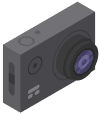To conduct good video analysis you need good footage.
To capture footage for post-analysis or for live analysis, Dartfish software is the answer for use with a wide range of video formats. That means video produced by most camcorders and a very wide range of other video sources.
To make your choice easier, we’ve listed below the most important device characteristics and selected our favorite video camera picks.
First, we’ll look at types of camera and video converters. Next, we’ll examine the most important camera specs.
Types of Cameras/Camcorders
There are more and more camera devices available for all budgets. Below, are the most common ones, for you to check out. In addition to the stand-alone cameras we’ve listed, the video converters provide live video stream.
Stand-Alone Cameras

Smartphones
The most recent smartphones have greatly improved camera quality. They fit in a pocket, 80% of us have one, and the high-end phones even have excellent image stabilization
A smartphone is a good alternative to:
- capture an athlete’s movement and give instant feedback
- film short game action to analyze a specific point.
If you need to capture qualitative footage, requiring a consistent battery along with storage, and if you need higher image quality enriched with motion tools, drawings, and angle info, consider devices that are more efficient.

Webcams
A typical webcam is compact, yet feature-packed. Some devices provide live stereo and wide-angle lenses, as well as multiple features to tweak and tune: frame rate, color, brightness, resolution, and more. For a relatively low price, you receive nice video quality, 15 megapixels, and smooth autofocus. You can also attach it to any standard tripod. For all these reasons, high quality webcams can be a cost effective solution.
Our recommendation: Logitech C922

Consumer Camcorders
With the advent of digital cameras and iPhones, budget camcorders are nowhere near as widespread as they once were. But they still have their strengths: they’re lightweight, easy to use and have extremely high optical zoom capabilities for the price.
Note however that this sort of camcorder needs a converter. (See our recommendations below).

Action Cams
GoPro is certainly the most famous action camera in action sport.
Action cameras are perfect when the cameraperson isn’t simply filming from the bench.
Tiny, robust, waterproof, they can be worn or be attached to the end of a monopod or a helmet and are ready to be used with all kinds of accessories. They’re perfectly suited for recording extreme sports like mtb downhill, rock climbing, or wakeboarding.
Standard cameras simply don’t offer that flexibility.
However, if you are filming from the sidelines, a GoPro or similar action camera is a needlessly expensive option. A good smartphone will do the job just as well, while a mirrorless camera or quality camcorder will produce better-looking videos.
Keep in mind that the action camera’s small sensor means grainy footage in low-light conditions (e.g. gyms). Moreover, you couldn’t record live, so usually, this sort of camera is only used for post-analysis.

Pro Camcorder
These are the best in the business, but cost a few thousand dollars at the very least, so we’ll pass on examining this high end camcorder.

IP Camera
An IP Camera plugs directly into your network router and is not dependent on a computer to work. Data from the IP camera is transmitted through the network and can be safely viewed from a remote location. An IP camera requires an Internet connection or a local network, a router and Ethernet cable, if you don’t choose to use a wireless camera.
Video from the camera is passed wirelessly to tablet or computers running Dartfish software.
IP cameras can be used to set up a network of fixed cameras. They are designed for being permanently switched on, while connected to the computer via a network (wired or wireless); it’s free from the cable length restrictions and can be easily weatherproofed.
Furthermore, according to the models, this camera has optical zoom and the image quality settings that you’d find on a camcorder; settings for exposure, focus and white balance can also be configured.
Learn how to use IP cameras with Dartfish
Our recommendations: Axis Q1615 MK II and Bosch autodome IP 5000 I

Video Converters
A video converter is a hardware device that turns one type of video signal into another. Examples include VGA to DVI, HDMI to DVI. Analysts may need a video converter to create a live video stream from a camcorder or from a broadcast video to your computer.
This means the analysts can record and store the incoming video feed on their laptops for later post-match analysis.
Our recommandations:

Comments are closed.